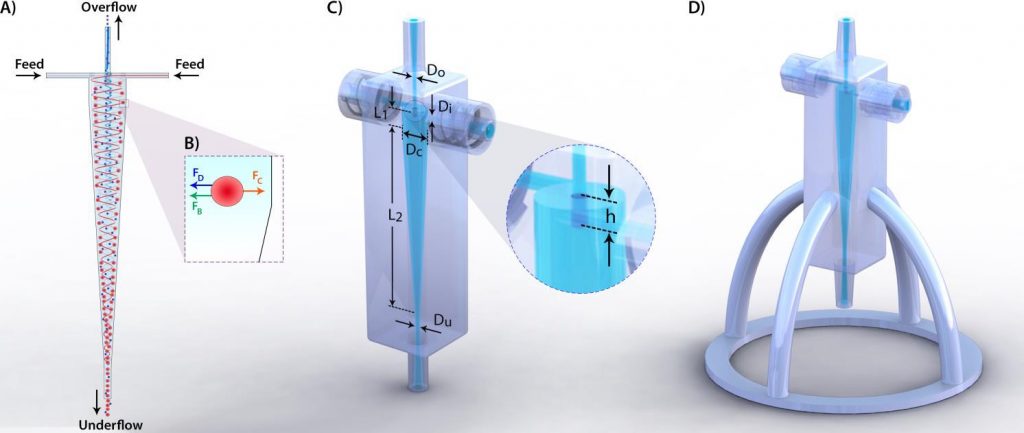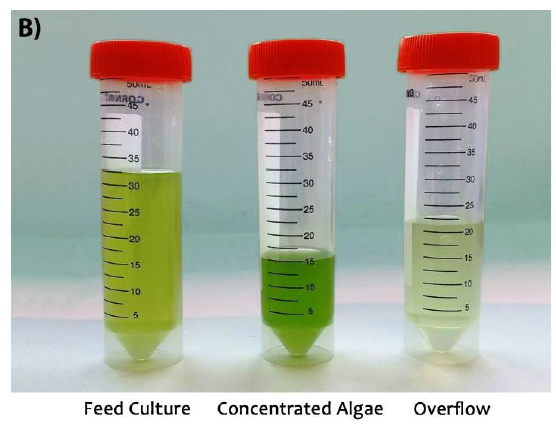Hydrocyclones are devices used across industry for separating particles from a liquid. Example applications include water treatment, air purification, and blood plasma separation – an essential step in disease diagnosis.
Noting difficulties in making these devices on a microfluidic scale – working with microscopic molecules – researchers from KU Leuven Campus Kulak, Belgium, Macquarie University and the University of New South Wales (UNSW), Australia, have proposed 3D printing as an alternative fabrication technique.
3D Printing Industry spoke to Dr. Majid E Warkiani, corresponding author on the 3D printed hydrocyclone study, and Principal Investigator of the Warkiani Group at UNSW to find out more.

Sorting by centrifugal force
At their most basic, hydrocyclones are down-pointing cones with three outlets: one at the side to deliver water; one at the top as an exit for small particles; and one at the bottom to deposit lager particles. They operate on the basis of centrifugal force, which works to direct the respective particles to a given outlet.
In his description of the process Dr. Warkiani explains,
In short, a mini-hydrocyclone is a low-cost device with no moving component which utilizes centrifugal force to promote the separation of heavy and light particles from a liquid mixture. This device directs inflow, which contains suspended particles, tangentially near the top of a cylindroconical vessel, thus generating centrifugal force in the liquid. Dense particles move outward toward the wall of the vessel where they agglomerate and spiral down the wall to the outlet at the bottom of the cyclone while lighter particles move toward the axis of the hydrocyclone where they move up toward the overflow outlet.
Other means of filtration
Alternatives to hydrocyclonic separation include centrifugation in a test-tube, without the benefits of the cone shape, and membrane filtration, where a liquid is poured through a material leaving a solid residue behind.
As outlined in the abstract of the 3D printed mini-hydrocyclone study, both of these alternative methods face limitations in relation to “clogging, processing time and operation efficiency”. In the study, Warkiani et al. mini-hydrocyclones are designed to avoid these limitations.
First, optimal hydrocyclone specifications were decided by performing a computerized investigation of the device’s fluid dynamics.

The hydrocyclone was then CAD modeled in SolidWorks, and 3D printed using a ProJet® 3500 HD Max multi jet 3D printer from 3D Systems.
The finished design, according to Dr. Warkiani, can be used “for small scale applications (1-100 ml of samples) or even large-scale applications (1-1000 liters).”

Turning algae into water
As a proof-of-concept, researchers then test the device’s ability to separate algae from water, finding and overall positive result.

Conclusions state that,
Our proposed mini-hydrocyclone has the capability to be employed for primary harvesting of algae, with decreasing operation time and energy requirements, greatly reduced areal footprint and easy installation as compared to other conventional harvesting methodolgies. In addition, it could separate marine species without any corrosion risks.
Dr. Warkiani indicates that these findings will lead the team to “build even better devices with higher separation efficiency,” to which he adds,
…we are going to showcase the utility of these systems in different applications and create a new generation of low-cost microfilters for different industires.
A mircrofluidic perspective
3D printed hydrocyclones are one of the latest developments in lab on a chip research – a method that allows scientists to test substances within the confines of a small, specially designed chip-device. Other 3D printing research in the field includes the Lego-brick concept of microfluidic fabrication and Harvard University’s organs-on-chip.
A 3D-printed mini-hydrocyclone for high throughput particle separation: Application to primary harvesting of microalgae discussed in this article is published online by the Royal Society of Chemistry in Lab on a Chip journal. It is co-authored by Maira Shakeel Syed, Mehdi Rafeie, Rita Henderson, Dries Vandamme, Mohsen Asadnia and Majid Ebrahimi Warkiani.
Stay up-to-date with the latest 3D printing news and research by subscribing to our newsletter and following us on twitter and Facebook.
Featured image: Diagram showing the inner workings of hydrocyclonic filters. Original image via scielo.br


